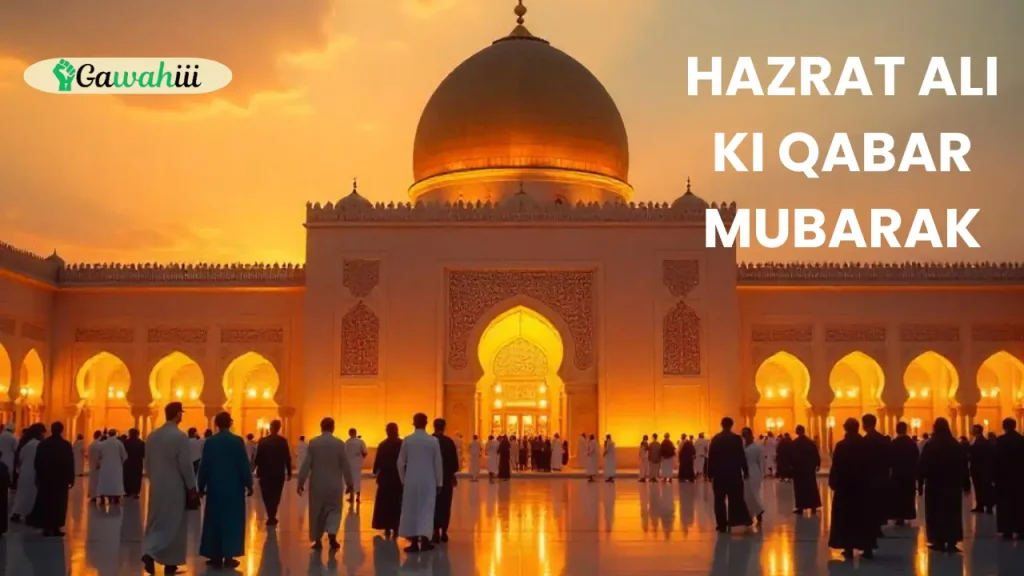Introduction
The fourth Caliph of Islam, Hazrat Ali (RA), who is a cousin and the son-in-law of Prophet Muhammad (PBUH), has a celebrated legacy in the history of Islam. The Muslims throughout the globe do remember his courage, intelligence, and profound faith in Islam. Another element that has remained curious to both the believers and historians is that of the final resting place of Hazrat Ali, which is termed Hazrat Ali ki Qabar Mubarak.
In this all-inclusive guide, we consider the place along with the historical and spiritual meaning of the shrine of Hazrat Ali. This paper will respond to your questions, dispel misunderstandings, and give you an in-depth knowledge of why his grave is regarded as so blessed.
Who is Hazrat Ali (RA)?
- Hazrat Ali ibn Abi Talib (RA) was a giant in early Islam.
- The first man to convert to Islam following the Prophet Muhammad (PBUH)
- He was remembered as a brave man of God whose sermons were eloquent and full of faithfulness.
- He was married to Fatimah (RA), the daughter of Prophet Muhammad (PBUH).
Elected as the 4th Caliph of Islam
Key Facts:
- Birth: 600 CE, Mecca
- Death: 661 CE, Kufa (present-day Iraq)
- Titles: Asadullah (Lion of Allah), Murtaza (The Chosen One)
The wisdom and direction of Hazrat Ali are timeless, and his words are still analyzed philosophically and theologically.
Hazrat Ali Ki Qabar Mubarak: Where is it located?
The shrine of Hazrat Ali is found in the city of Najaf, Iraq, which is one of the holiest cities to Muslims, particularly the Shia Muslims.
- City: Najaf
- Country: Iraq
- Mosque: Imam Ali Mosque
Why Najaf?
- The historical sources agree with historical facts stating Hazrat Ali was martyred in Kufa and buried secretly in Najaf as a way of saving the grave of Hazrat Ali and not having it violated by the enemies.
- His grave site was unearthed and transformed into a magnificent shrine.
Characteristics of the Shrine:
- Two lofty minarets and a golden dome
- Quranic writings and fancy gridwork
- Millions of pilgrims come every year.
Spiritual Significance of the Shrine
More than only a historical relic, Hazrat Ali’s Qabar Mubarak represents spiritual awakening and self-sacrifice.
Justifications for its respect:
- Hazrat Ali passed away while in prayer, a final sign of devotion.
- Many people think going to his shrine heals them physically and spiritually.
- Visitors show sincere prayers, trusting he hears them via his intervention through Dua’s Gateway.
Historical records of the tomb
Various narratives around Hazrat Ali’s interment lend to its magical character.
Major Historical Notes:
Reportedly, under cover of night, Hazrat Hassan (RA) and Hazrat Hussain (RA) buried him.
The grave remained hidden for more than a century to prevent desecration.
Harun al-Rashid, Abbasid Caliph, next rediscovered and appreciated it.
Table of Comparisons: Sunni versus Shia Beliefs on the Burial
| Aspect | Sunni View | Shia View |
|---|---|---|
| Burial Location | Najaf (widely accepted) | Najaf |
| Grave secrecy | For protection | For protection and prophecy fulfillment |
| Shrine Importance | Respected | Extremely sacred |
Architecture and Beauty of the Shrine
Islamic architecture is best shown at the shrine.
Architectural Elements:
- Golden Dome stands for endless honor.
- Covers the tomb grounds, Silver Zarih.
- Writings: Hadiths and Quranic passages etched on walls
- Spacious courtyard filled with pilgrims from all walks of life
Highlights from bullets:
- Reclaimed over centuries by several Muslim kings
- Foundational materials that can withstand earthquakes
- Home to a library with thousands of Islamic writings.
Pilgrimage to Hazrat Ali Ki Qabar Mubarak
Visiting Hazrat Ali’s shrine is a deep spiritual voyage called Ziyarat.
Pilgrimage steps:
- Intention (Niyyah)
- Enter with humility.
- Recite particular Ziyarat scriptures.
- Give dua and nawafil.
- Consider and ponder at the tomb.
Advice for Pilgrims:
- Come during nonpeak hours to miss crowds.
- Dress plainly.
- Honor local traditions and shrine holy status.
Political and cultural influence
Besides being a religious site, Hazrat Ali’s shrine has played a role in regional politics and unity.
Past Events:
- Many Muslim intellectuals and revolutionaries came by.
- Places where peace treaties have been developed throughout history
- Symbol of fairness and defiance
Example:
The shrine was a focus for national unity during Iraq’s 1920 rebellion.
Legacy of Hazrat Ali and Teachings
The ideals Hazrat Ali exemplified are reflected inside the walls of his mausoleum.
His legacy:
- Justice: Noted for equitable management
- Founder of Islamic law knowledge
- Bravery: undefeated in important battles
Notable Quotations:
“He who possesses a thousand friends has no friend to spare.”
“People are slaves to this world, and as long as they live favorable and comfortable lives, they are loyal to religious principles.”
Miracles and Anecdotes Associated with the Shrine
Stories about Hazrat Ali’s Qabar Mubarak abound.
Anecdotal Illustrations:
- The pilgrims’ incurable ailments were healed.
- Lost persons getting direction after prayers at the shrine
- Dreams of Hazrat Ali leading visitors
Significant Account:
An ancient South Asian man said his blindness was magically healed following a sincere prayer at the temple.
Travel Guide and Advice on Visiting Najaf Today
Planning a Ziyarat to Hazrat Ali ki Qabar Mubarak requires knowledge of the following:
Essentials for Traveling:
- Visa: Most nations require this.
- Best time to see: Either after Muharram or before Ramadan
- Nearby places: Kufa Mosque; WadiusSalaam burial ground
Comfort and Safety:
- Najaf is somewhat well-guarded and calm.
- Pilgrims get a warm welcome.
- For historical background, consult local guides.
- Visual Data and Tables
Table: Essential Events and Dates
| Event | Year (CE) |
|---|---|
| Birth of Hazrat Ali | 600 |
| Martyrdom in Kufa | 661 |
| Rediscovery of Grave in Najaf | ~8th Century |
| First major shrine reconstruction | 977 |
FAQ About Hazrat Ali Ki Qabar Mubarak
In Najaf, Iraq, is Hazrat Ali interred?
Most historians and Islamic scholars concur that Hazrat Ali is buried in Najaf.
Are Sunnis welcome at Hazrat Ali’s shrine?
Yes, both Sunni and Shia Muslims come to the shrine to show respect.
Has evidence of his burial site historically survived?
Though early concealment adds a layer of mystery, historical evidence and oral legends point to Najaf as the burial ground.
Which duas are advised throughout the ziyarat?
Ziyarat Ameenullah and other required prayers are frequently recited.
Has the shrine related any miracles?
Yes, after their visit, many pilgrims claim bodily and spiritual benefits.
Consulsion:
More than merely a graveside, the blessed tomb of Hazrat Ali (RA) in Najaf is a spiritual refuge visited by millions for meditation and devotion. From cultural relevance to extraordinary events and historical proof, Hazrat Ali ki Qabar Mubarak is a beacon of faith, fortitude, and brotherhood in the Muslim community.
A visit or even studying about this holy place can be really life-changing if you’re looking for ideas, treatment, or a greater awareness of Islamic history. May the light of Hazrat Ali’s legacy lead your heart, whether you are organizing a ziyarat or looking from the outside.
- Also read this:
- part







